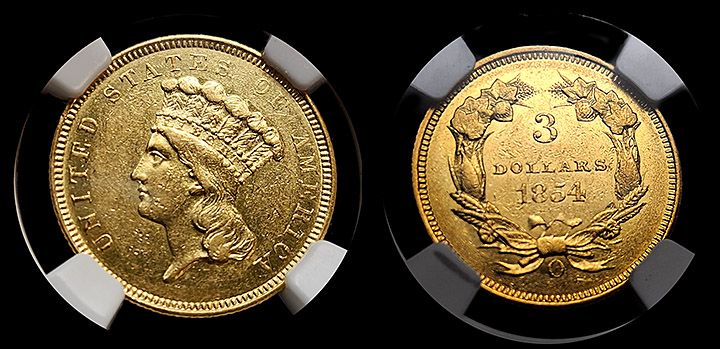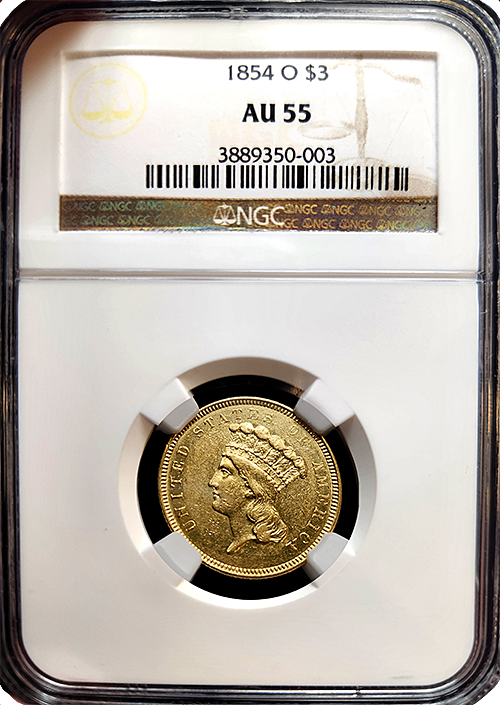
The enigmatic $3 Indian Princess coin, minted by the United States from 1854 to 1889, is a numismatic gem. Especially because of its rarity and beauty and the fascinating story behind its creation and circulation. Chiefly, the coin itself is a piece of art. At the same time, the tale of its inception embodies a deeper understanding of its significance in American history.
The Economic Context: A Nation in Flux
The mid-19th century was a period of significant economic and territorial expansion for the United States. Moreover, the discovery of gold in California in 1848 set off the Gold Rush. Basically, the increase in gold flooded the economy with gold and prompted new considerations for coinage. During this time, the U.S. government sought to streamline and expand its currency system. Specifically, the expansion better served the rapidly growing and geographically expanding nation.
One of the primary reasons behind the creation of the $3 coin was to facilitate the purchase of postage stamps. Thus, they were sold in sheets of 100 stamps for $3. This idea, though somewhat niche, made practical sense. However, it was in an era when the postal service was an essential communication network across the sprawling country.
Detailed Economic Impact of the Gold Rush
The California Gold Rush of 1848 brought immense wealth into the U.S. economy. Prospectors flocked to California, extracting significant amounts of gold. This sudden influx of gold created a need for new gold coinage. The U.S. Mint had to respond quickly to this economic windfall. Part of this response was the introduction of new denominations, like the $3 coin.
Gold from California increased the U.S. money supply, affecting inflation and economic growth. The government's decision to introduce new gold coins was partly to manage this new wealth effectively. The $3 coin was an innovative solution to incorporate this gold into daily commerce.
Political and Legislative Drivers
The introduction of the $3 coin was closely tied to the Coinage Act of 1853. This legislation aimed to adjust the weight of silver coins to reflect their intrinsic value more accurately and to reintroduce gold coins into general circulation. Senator Robert M.T. Hunter of Virginia, a key proponent of the act, argued for a $3 gold piece as a logical addition to the existing denominations. Hunter believed the new coin would help bridge the gap between the $2.50 Quarter Eagle and the $5 Half Eagle, providing more transaction flexibility.
In 1854, the proposal was accepted, and the $3 gold coin was authorized by the U.S. Congress. This marked the beginning of its brief but memorable journey in American coinage history.
In-depth Look at the Coinage Act of 1853
The Coinage Act of 1853 was crucial for U.S. monetary policy. It aimed to standardize and stabilize the nation's coinage system. The act reduced the silver content in smaller denomination coins, aligning their value with market prices. This change helped prevent the melting down of coins for their metal content.
The act also reintroduced gold coinage into regular circulation. The $3 coin was part of this broader initiative. Senator Hunter advocated for the $3 coin based on practicality and convenience. This new denomination aimed to make transactions smoother, especially in the context of postal services and other specific needs.
 Design and Symbolism
Design and Symbolism
James B. Longacre, the Chief Engraver of the United States Mint, was tasked with designing the $3 gold coin. Longacre was already renowned for his work on other U.S. coins, including the Indian Head Cent. For the $3 coin, he drew inspiration from Native American imagery, a choice that was both aesthetically pleasing and symbolically significant.
The obverse of the coin features Lady Liberty wearing a Native American headdress. This design, often called the "Indian Princess," was intended to symbolize America. Consequently, it also reflected the nation's cultural heritage and the noble virtues of Native American societies. The reverse of the coin, with its wreath of corn, cotton, wheat, and tobacco, represented the agricultural abundance and economic diversity of the United States.
James B. Longacre's Design Process
James B. Longacre faced challenges while designing the $3 coin. He wanted the design to reflect American ideals and heritage. The choice of a Native American headdress was deliberate. It symbolized America's roots and cultural respect. Longacre's design process involved balancing aesthetics with symbolism.
He meticulously crafted the obverse to capture Liberty's nobility. With its agricultural motifs, the reverse design celebrated the nation's bounty. Longacre's vision was to create a beautiful and meaningful coin. Undeniably, his efforts resulted in a design that stood out in American numismatics.
Practical Challenges and Limited Circulation
Despite its beautiful design and the practical reasoning behind its creation, the $3 coin faced numerous challenges. One major issue was its awkward denomination. The coin was initially intended to simplify the purchase of postage stamps. However, the need for such a specific denomination did not translate well into everyday commerce. Merchants and consumers found it cumbersome to use, and it did not fit neatly into the established currency system.
Furthermore, the $3 coin was often hoarded rather than circulated, as many people saw it as a collectible or a store of value rather than a practical currency. Its limited production numbers also contributed to its rarity and the perception of it as more of a novelty than a useful coin.
Public Reception and Usage
The public reception of the $3 coin was mixed. While some appreciated its design, many found it impractical. The coin struggled to find a place in daily transactions. Its awkward denomination made it less useful in typical commerce, and merchants often preferred more familiar denominations.
The $3 coin's primary use remained sparse, and few used it to buy postage stamps. Therefore, it did not circulate widely. Those who hoarded them as collectibles or gifts contributed to its eventual discontinuation.
Historical Footnote: The Coin’s Demise
The $3 Indian Princess coin was minted for 35 years, from 1854 to 1889. However, its production was sporadic, with significant drops in mintage in certain years. By the late 1880s, the economic rationale for the coin had diminished further. The rise of paper currency and more standardized coinage reduced the need for such specific denominations. In 1889, the production of the $3 coin ceased entirely.
The discontinuation of the $3 gold piece marked the end of an era. Today, the coin is a prized item among collectors, valued not just for its gold content but for its historical significance and the story it tells about a dynamic period in American history.
Legacy and Collectible Status
The legacy of the $3 Indian Princess coin endures in the world of numismatics. Its unique denomination, coupled with the beautiful design by James B. Longacre, makes it a standout piece for collectors. The coin’s history offers a glimpse into the economic and political forces. Besides, it was one of the mid-19th century and the artistic aspirations of the U.S. Mint during that era.
Owning a $3 Indian Princess coin is like holding a piece of history—a tangible connection to the past. Certainly, a past that reflected a growing nation's ambitions, challenges, and creative endeavors. Whether appreciated for its aesthetic beauty, rarity, or historical context, the $3 gold coin remains a fascinating chapter in the story of American coinage.
Collectibility and Legacy
The $3 coin's legacy lives on in numismatic circles. Its rarity and design make it highly collectible. Auctions often feature these coins, fetching high prices. Collectors value the coin for its beauty and historical significance. Notable sales have highlighted its desirability.
The coin's story adds to its allure. Collectors appreciate the historical context and craftsmanship. The $3 Indian Princess coin remains prized, representing a unique chapter in American coinage history.
Conclusion
The enigmatic $3 Indian Princess coin encapsulates a unique period in American history. Additionally, it reflected the economic impact of the Gold Rush. After that, it echoed the legislative changes of the Coinage Act of 1853 and the artistic vision of James B. Longacre. Its beautiful design and limited circulation make it a highly sought-after collectible. Despite its practical challenges, the coin's historical significance and aesthetic appeal continue to captivate numismatists and collectors.
Stay tuned for the latest new post for more stories about interesting rare coins at Austin Rare Coins Blog.
